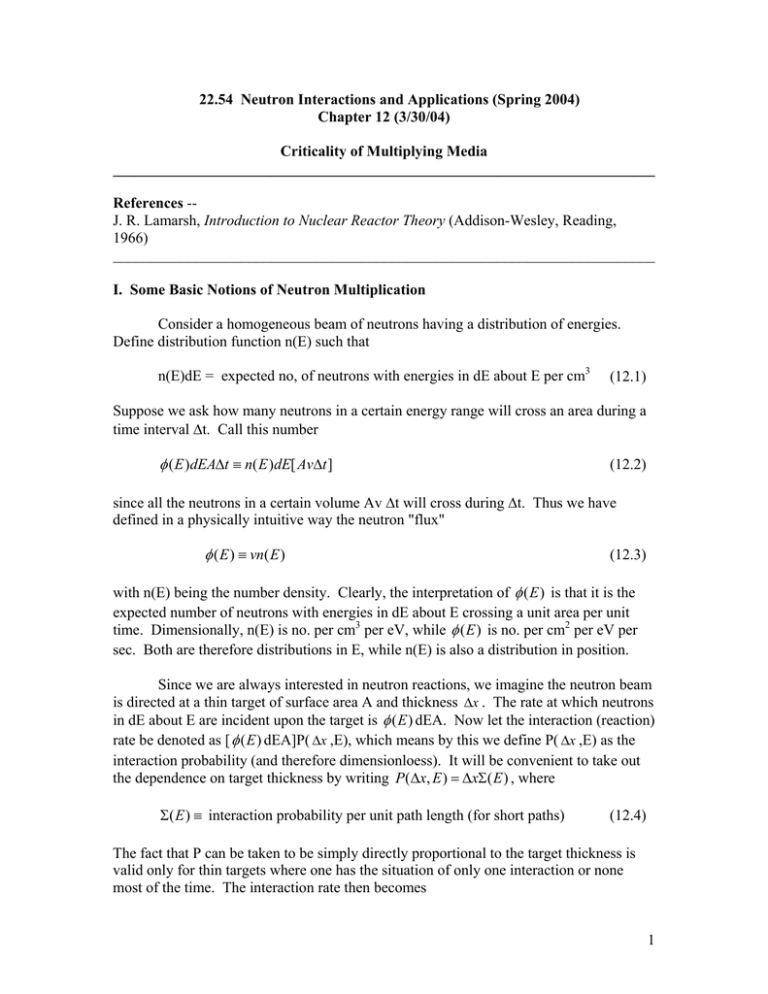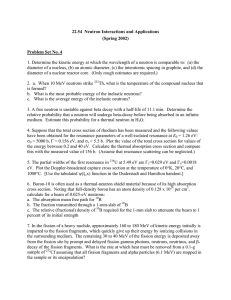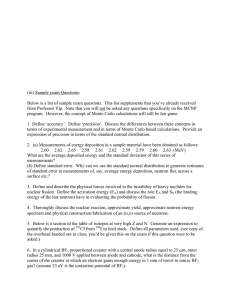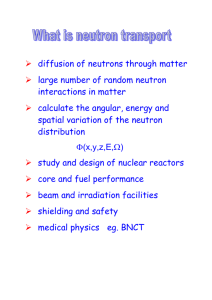22.54 Neutron Interactions and Applications (Spring 2004) Chapter 12 (3/30/04)
advertisement

22.54 Neutron Interactions and Applications (Spring 2004) Chapter 12 (3/30/04) Criticality of Multiplying Media ________________________________________________________________________ References -J. R. Lamarsh, Introduction to Nuclear Reactor Theory (Addison-Wesley, Reading, 1966) ________________________________________________________________________ I. Some Basic Notions of Neutron Multiplication Consider a homogeneous beam of neutrons having a distribution of energies. Define distribution function n(E) such that n(E)dE = expected no, of neutrons with energies in dE about E per cm3 (12.1) Suppose we ask how many neutrons in a certain energy range will cross an area during a time interval ∆t. Call this number φ ( E )dEA∆t ≡ n( E )dE[ Av∆t ] (12.2) since all the neutrons in a certain volume Av ∆t will cross during ∆t. Thus we have defined in a physically intuitive way the neutron "flux" φ ( E ) ≡ vn( E ) (12.3) with n(E) being the number density. Clearly, the interpretation of φ ( E ) is that it is the expected number of neutrons with energies in dE about E crossing a unit area per unit time. Dimensionally, n(E) is no. per cm3 per eV, while φ ( E ) is no. per cm2 per eV per sec. Both are therefore distributions in E, while n(E) is also a distribution in position. Since we are always interested in neutron reactions, we imagine the neutron beam is directed at a thin target of surface area A and thickness ∆x . The rate at which neutrons in dE about E are incident upon the target is φ ( E ) dEA. Now let the interaction (reaction) rate be denoted as [ φ ( E ) dEA]P( ∆x ,E), which means by this we define P( ∆x ,E) as the interaction probability (and therefore dimensionloess). It will be convenient to take out the dependence on target thickness by writing P (∆x, E ) = ∆xΣ( E ) , where Σ( E ) ≡ interaction probability per unit path length (for short paths) (12.4) The fact that P can be taken to be simply directly proportional to the target thickness is valid only for thin targets where one has the situation of only one interaction or none most of the time. The interaction rate then becomes 1 Σ( E )φ ( E )dEV The product Σ( E )φ ( E ) , or the spatial-dependent form Σ(r , E )φ (r , E ) , appears frequently in reactor physics discussions; it is often called the 'collision density'. Despite this nomenclature, we should keep in mind that it is a distribution function in energy and space, and is also a rate. We have previously introduced the macroscopic cross section Σ(r , E ) to represent the target property that is most relevant to the consideration of neutron interaction in a material medium. Recall that Σ = Nσ , where N is nuclear density, the number of target nuclei per cm3, and σ ( E ) is the microscopic cross section. When the medium is not homogeneous, then nuclear density can vary position in which case N becomes position dependent. In any event, the spatial and energy dependence of Σ is separable. For problems of neutronics of multiplying systems, we need to take into account several types of reactions. This can be expressed by writing a decomposition of the total cross section as a sum of scattering, capture, and fission cross sections, and the term absorption is used to denote the sum of capture and fission. σ t (E) = σ s (E) + σ a (E) (12.5) σ a (E) = σ c (E) + σ f (E) (12.6) The basic reason that reactor physics has its own unique flavor (and this is the reason for us to study it) is that the materials which make up a nuclear reactor have characteristic cross sections that make each reaction important at low or high neutron energies, but usually not both. For a thermal reactor with uranium fuel, the fission cross section of U235 is large (several hundred barns) at thermal energy but about 1 barn at the energy where fission neutrons come off. In contrast the capture cross section σ (n, γ ) of U238 can be quite large in the resonance energy region (between thermal and fast), and is also nonnegligible at thermal energy. The scattering cross section, to a first approximation, can be taken to be just a constant throughout the entire energy range of interest. Combining these variations with the fact that neutrons emitted from a fission reaction have a distribution peaked around 2 MeV, we have the situation of maintaining a chain reaction where neutrons are introduced into the system at high energy, but they need to slow down to thermal energy where the probability of their causing further fission reactions is the greatest. This then is the essence of the fundamental problem of criticality in all of reactor physics. The Fission Reaction While we will refer the students to any standard text on nuclear reactor theory, such as the very readable text by J. Lemarsh cited above, for a discussion of the various neutron interactions relevant to the operation of a nuclear reactor system, we note here a 2 few basic facts about the fission event in recognition of the important role of neutrons in nuclear power production. A typical fission reaction in U235 induced by a thermal neutron is: U +n→ 235 92 95 42 Mo + 139 57 La + 2n From mass balance we have (1 amu = 931 MeV) M(U) + M(n) = 236.133 amu M(Mo) + M(La) + 2M(n) = 235.918 mass difference ∆ = 0.215 amu or about 200 MeV The distribution of this energy is: kinetic energies of fission fragments fission product decay γ β neutrinos prompt γ kinetic energies of fission neutrons 168 MeV 7 8 12 7 5 ~ 207 All the energies except those of the neutrinos are recoverable in the form of heat. In addition, each parasitic absorption (capture) of a neutron leads to capture γ whose energies ~ 12 MeV are also recoverable. Thus the total energy recoverable is ~ 207 MeV. In contrast, for D-D fusion reaction, 4H1 → He4, 4M(H) = 4.13258, M(He) = 4.0038, ∆ ~ 26.7 MeV. It may seem that fission is the better energy source since more energy is released per reaction. However, because there is so much more hydrogen than uranium in the world, fusion power, when feasible, would be the ultimate source of energy. We know from the binding energy curve that when a nucleus with mass A ~ 240 breaks into two fragments, A1 and A2, the total binding energy BE after the reaction is greater than that before. So energy must be supplied in order to make the reaction go. Such energy can be provided in several ways, such as, neutron capture, photofission by capture of γ , and charged particle reaction. It is known experimentally that photofission is a threshold event, the minimum excitation energy required being: 3 U233 U235 U238 Pu239 Th232 _____________________________________________________ 5.9 5.5 5.75 5.85 5.5 MeV In view of such data, a question for the student is: If fission is a threshold reaction, how then can thermal neutrons induce fission? Some facts worth keeping in mind about neutron-induced fission: The mass distribution of fission fragment mass is not symmetric; an empirical rule holds that the most probable charge distribution is one in which the proton deficiency is the same in the two fragments, with the two peaks centered at A ~ 94 and 142. Some of the neutrons emitted from fission appear with significant time delays, up to seconds because β decay processes can be quite slow. The role of delayed neutrons is critical in reactor control under normal operations; without delayed neutrons the population of neutrons from one generation to the next will change exponentially. Energy distribution of fission neutrons follows the so-called Watts spectrun which peaks at ~ 0.7 MeV with average energy at ~ 1.9 MeV. Average number of neutrons emitted per fission event (ν ) varies somewhat from one fissile nucleus to another. It is mildly energy dependent. For U235 ν = ν (thermal) + constant x E (MeV), with ν (thermal) = 2.43 and constant = .1346 MeV-1 Criticality A simple way of stating the criticality problem is to consider how one might estimate the critical condition to maintain a self-sustained fission chain reaction. This example is quite instructive in showing the role of different types of neutron interactions, and the interplay between materials properties and geometric factors. Suppose we separate all neutrons into either the fast (F) or high-energy group or the thermal (T) group. We begin by introducing a fast neutron into the homogenized (no spatial variation) reactor, and then follow all the contributions to the next generation of neutrons that it can possibly make (much like what one would do in MCNP). Four things can happen to the neutron as it move through the reactor, it can escape from the reactor (fast leakage) contributing nothing to the next generation, undergo a fission reaction (fast fission) contributing ν PNFL PFF , undergo a capture reaction contributing nothing, or undergo a scattering interaction. The contribution of the fourth event is a little more complicated to estimate. We will assume that any scattering of a fast neutron will cause it to become a thermal neutron (we can come back to examine this later on). Then three things can happen to this thermal neutron, it can escape from the reactor as a thermal neutron (thermal escape), undergo a capture reaction (thermal 4 capture), or undergo a fission reaction (thermal fission). The first two events contribute nothing to the next generation while the third gives ν PNFL PFS PNTL PTF . For the various probabilities, we can estimate those pertaining to reactions using the corresponding Σ , while leaving aside the non-escape probabilities to be discussed later. PFF = Σ FF , Σ FA + Σ FS PFS = Σ FS , Σ FA + Σ FS PTF = ΣTF ΣTA (12.7) If we add up all the contributions to the next generation, the sum k is then the multiplication constant of the reactor. That is every succeeding generation is multiplied by a factor k. From the above scenario, we see there are two contributions to k, one from fast fission and the other from thermal fission. All other processes represent loss of neutron with no further contribution. Thus, k = ν PNFL [ PFF + PNTL PFS PTF ] (12.8) In terms of k we can now define what we mean by a critical reactor, namely, k = 1. For k > 1, the neutron population increases by a factor k for every generation, so the reactor is said to be 'supercritical', whereas for k < 1, the system is 'subcritical' and cannot maintained a self-sustained chain reaction. In the supercritical case, how quickly the reactor 'runs away' (neutron flux increases too quickly for the control system to maintain the reactor in a safe operating state) is a major concern. We will come back to discuss this situation before too long. The multiplication constant k is perhaps the most fundamental quantity in reactor physics calculations. It is conventional to recast it into a form that separates out the spatial effects of neutron escaping from the system from the materials effects of various reactions. We rewrite k as k = k∞ PNFL PNTL k∞ = ν PFF + PNTL PFS PTF PNTL = η fpε with (12.9) (12.10) η = ν PTF (12.11) p = PFS (12.12) 5 ε = 1+ PFF PNTL PTF PFS (12.13) The quantity k∞ is known as the infinite medium multiplication constant; it is the multiplication constant when the reactor can be considered to be an infinite system. Since there is no leakage from an infinite system, it is not surprising that k∞ should be modulated by the two non leakage probabilities, as indicated in (12.9), to give the multiplication constant for a finite reactor. Incidentally, k is often called the effective multiplication constant and denoted also as keff. Eq.(12.10) shows that k∞ is the product of four factors. In reactor physics terminology, (12.10) is known as the four-factor formula. Here η is the average number of neutrons emitted per fission event, the thermal utilization factor f denotes the probability that the absorption of a thermal neutron takes place in the fuel rather than anywhere else (since we have only fuel in the present simple example, f = 1), p is the resonance escape probability, referring to the fact that in slowing down from fast to thermal energy the neutron must avoid any resonance absorption reaction, and ε is called the fast fission factor because it is the sum of fast and thermal fission contributions. We see also that the multiplication constant is just the product of k∞ and the two non-escape probabilities. Given that k∞ refers to an infinite system, we may expect it to depend purely on material properties. Thus it may seem a little strange that k∞ involves PNTL (see for example, Eq. (12.13)) which is a property that depends on the system size. A bit of reflection shows that the origin of this puzzling behavior arises from the fact that we started out in our analysis with a model of a finite system and then obtain k∞ by extracting it from our finite-system result, Eq. (12.8). This observation indicates that there are different ways one can estimate k∞ , and the result for k∞ can vary from one case to another. Is there a unique k∞ ? We think so; it is the multiplication constant one finds when one starts at the outset with an infinite system. What about the expressions for k∞ which seem to still involve system size, such as our present estimate? We think they are all model-dependent approximations. The non-uniqueness of extracting k∞ from finite-system models suggests that system size and material property effects, strictly speaking, are not separable in the determination of the multiplication constant. To get a feel for the various numbers one can consult a figure such as Fig. 1 below that shows the variation of ε , f, p and k∞ for a homogeneous reactor. In this particular case the reactor is a homogeneous mixture of 2% enriched uranium as fuel and H2O as moderator at various concentration ratios (x) of fuel to moderator. Although not shown, the value η (U235) is a constant at ~ 2.06. 6 The main feature to notice in Fig. 1 is that k∞ does not increase indefinitely with the fuel concentration. Since ε increases only slightly with x, the value of k∞ is determined mostly by the competition between f and p. It is reasonable that with increasing x thermal utilization will initially increase rapidly but the effects then saturates. In contrast the resonance escape probability does not show any saturation and thus causes k∞ to decrease when f starts to saturate. The peak value of k∞ at about 1.27 sets the limit on the product of the two non-leakage probabilities if the reactor is to be critical. 1.4 0.4 0.2 0.070 0 0 -------------------- 0.6 k 8 0.8 -------------------- 1.0 -------------------------- 1.2 f P X max 0.4 = 0.36 0.8 2.5 1.2 1.6 2.0 2.4 2.8 3.2 Fig. 1. Variation of the infinite medium multiplication constant k∞ and three of its component factors, the thermal utilization f, the resonance escape probability p, and the fast fission factor ε with the concentration ratio of fuel to moderator. The range of concentration ratio where k∞ is greater than unity is between 0.070 and 2.5, and the maximum value k∞ can have is about 1.27. 7






